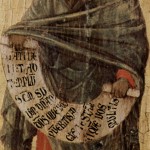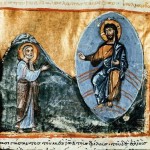 The lectionary giveth and the lectionary taketh away. Every minister I know (at least the ones who follow the lectionary) has weeks when the lectionary isn’t as compelling as it is at other times. In my experience, this is different for different ministers. What one person finds boring or uninspiring, others find thrilling. That is to say, different people react differently to different texts.
The lectionary giveth and the lectionary taketh away. Every minister I know (at least the ones who follow the lectionary) has weeks when the lectionary isn’t as compelling as it is at other times. In my experience, this is different for different ministers. What one person finds boring or uninspiring, others find thrilling. That is to say, different people react differently to different texts.
This week’s texts don’t do much for me. That’s probably a failure on my part as much as anything. But I just can’t get going with them. You’ll probably be different, so I encourage you to chime in down below in the comments and give us all your inspired thoughts!
Onward to this week’s lectionary texts!
What It’s About: Snakes on a plain! (That’s a little St. Patrick’s Day humor for you).
What It’s Really About: This is the story about the other side of the mountain. Have you ever had one of those “mountaintop experiences,” when everything made sense and felt good? And then you go back to the real world and realize that things are not as easy as they seemed up there, basking in the glow? The Israelites are in that spot. They’ve emerged from the glow of their mountaintop experience with God, and as they journey outward from Sinai into the wilderness they begin to complain. This is one of the so-called “complaint stories” in Numbers, in which the people grumble about how it might have been better to just have died in Egypt. They’re so disgruntled that they aren’t even making sense: “There’s no food and no water, and we detest this miserable food.”
What It’s Not About: It’s not really about the snakes. The snakes, here, are a way of illustrating the relationship between the people’s complaining and God’s (lack of) patience with them.
Maybe You Should Think About: This is a tricky text to preach. On the one hand, it’s a nice cautionary tale about the dangers of grumbling and complaining. On the other hand, it doesn’t describe God as being on the best behavior either. It reminds me a lot of my relationship with my kids, when they’re not behaving, and then I get upset and overreact, which makes them behave worse, and so on. But are we to understand the Israelites here like petulant children? Or do they have a legitimate complaint? The personified, personal God of the Hebrew Bible allows for that, I think. This is a God against whom you can complain.
What It’s About: God’s help in trouble.
What It’s Really About: God’s help in trouble.
What It’s Not About: Can I make a confession? I don’t always love the Psalms. I have a colleague who has them all memorized, and who finds great meaning in the Psalms. Me? Some of them are great, and some of them are just fine, but some of the Psalms are among my least favorite parts of the bible. This Psalm gets better later on, in my opinion, but this lectionary text isn’t about that. This is about mirroring the wilderness experiences in the Numbers text above.
Maybe You Should Think About: Maybe you should think about the context for a psalm like this. Why does it get written, and by whom, and for whom? What’s it for? I can imagine a community beset by trouble, being comforted while praying or singing this together. Does that sort of community have anything in common with your community?
What It’s About: This is about the work of God in Jesus.
What It’s Really About: This is really about how the earliest Christians worked out the meaning of Jesus, in the first decades after his death.
What It’s Not About: Scholars are divided over whether Ephesians was written by Paul. There are some compelling arguments on both sides, but usually the results break down along ideological or theological lines: conservative Christians think Paul wrote this, and liberal Christians and secular scholars have their doubts. I teach my own students to think of Ephesians as one of the “disputed epistles.” But this section more than others in the letter make me think that Ephesians might be Pauline after all. This just feels like Paul. It makes sense in all the Paul ways, and it doesn’t make sense in all the usual ways Paul doesn’t make sense. I often describe Paul’s writing as elliptical–it loops and sweeps around before coming to rest somewhere. That’s what’s going on in Ephesians 2: the writer is taking a few different runs at the questions of human nature, salvation, and the roles of faith and works.
Maybe You Should Think About: The other sense in which this sounds really Pauline is that in verses 8 and 9 the saving work is attributed to God, and not to the actions of humans. And–this is critical–Jesus doesn’t even play a large role. Although Jesus is certainly present in the passage, Jesus here is the conduit of God’s grace, not the instigator of it. This is an aspect of Paul’s theology that’s often overlooked: for Paul, it’s always still God from whom salvation flows.
What It’s About: Snakes again!
What It’s Really About: Drawing a parallel between the saving power of the serpent staff in Numbers and the saving power of Jesus.
What It’s Not About: It’s not about John 3:16! My New Testament class was reading John the other day, and we paused to remark on just how bizarre is our cultural fascination with John 3:16. It has taken its place as THE verse explaining Christianity, but in the flow of the first part of the gospel of John, it’s not a particularly important verse. It represents a crescendo, to be sure, and it is a nice summation of what came before it, but this verse doesn’t really deserve its place on all those end-zone signs.
Maybe You Should Think About: What did the author of John hope to convey by the comparison to Numbers? What, exactly, does Jesus have in common with that serpent staff? Is merely looking to Jesus salvific? Does Jesus exist to save us from God’s wrathful retribution for our complaining? It’s not a perfect comparison. How can those two relate to each other?
Photo Credit: kwest / Shutterstock












